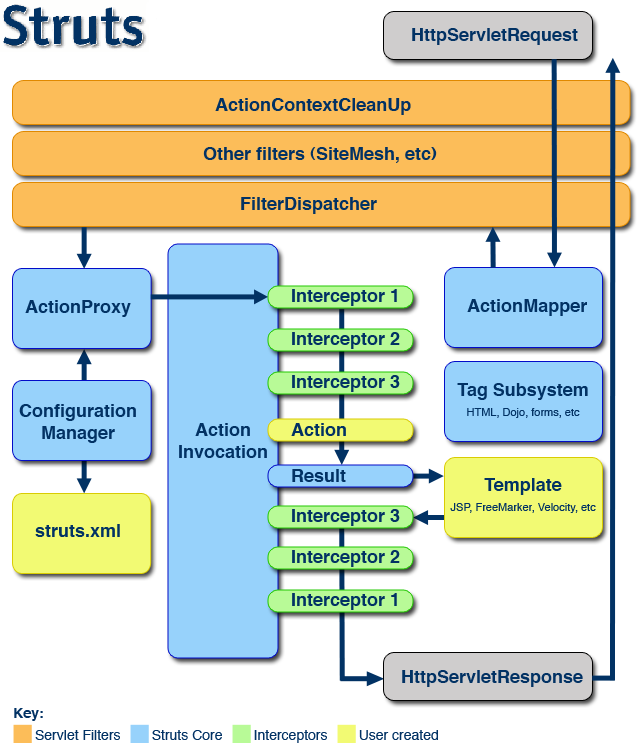这是S truts2官方站点提供的Struts 2 的整体结构。

2. Struts2部分类介绍
这部分从Struts2参考文档中翻译就可以了。
ActionMapper
ActionMapper其实是HttpServletRequest和Action调用请求的一个映射,它屏蔽了Action对于Request等java Servlet类的依赖。Struts2中它的默认实现类是DefaultActionMapper,ActionMapper很大的用处可以根据自己的需要来设计url格式,它自己也有Restful的实现,具体可以参考文档的docs\actionmapper.html。
ActionProxy&ActionInvocation
Action的一个代理,由ActionProxyFactory创建,它本身不包括Action实例,默认实现DefaultActionProxy是由ActionInvocation持有Action实例。ActionProxy作用是如何取得Action,无论是本地还是远程。而ActionInvocation的作用是如何执行Action,拦截器的功能就是在ActionInvocation中实现的。
ConfigurationProvider&Configuration
ConfigurationProvider就是Struts2中配置文件的解析器,Struts2中的配置文件主要是尤其实现类XmlConfigurationProvider及其子类StrutsXmlConfigurationProvider来解析。
3. Struts2请求流程
1、客户端发送请求
2、请求先通过ActionContextCleanUp-->FilterDispatcher
3、FilterDispatcher通过ActionMapper来决定这个Request需要调用哪个Action
4、如果ActionMapper决定调用某个Action,FilterDispatcher把请求的处理交给ActionProxy,这儿已经转到它的Delegate--Dispatcher来执行
5、ActionProxy根据ActionMapping和ConfigurationManager找到需要调用的Action类
6、ActionProxy创建一个ActionInvocation的实例
7、ActionInvocation调用真正的Action,当然这涉及到相关拦截器的调用
8、Action执行完毕,ActionInvocation创建Result并返回,当然,如果要在返回之前做些什么,可以实现PreResultListener。添加PreResultListener可以在Interceptor中实现。
另一个版本:大同小异~
一个请求在Struts2框架中的处理大概分为以下几个步骤:
1. 客户端提起一个(HttpServletRequest)请求,如上文在浏览器中输入”http://localhost:8080/TestMvc/add.action”就是提起一个(HttpServletRequest)请求。
2. 请求被提交到一系列(主要是三层)的过滤器(Filter),如(ActionContextCleanUp、其他过滤器(SiteMesh等)、 FilterDispatcher)。注意这里是有顺序的,先ActionContextCleanUp,再其他过滤器(SiteMesh等)、最后到FilterDispatcher。
3. FilterDispatcher是控制器的核心,就是mvc中c控制层的核心。下面粗略的分析下我理解的FilterDispatcher工作流程和原理:FilterDispatcher进行初始化并启用核心doFilter
其代码如下:
Java代码 复制代码
public void doFilter(ServletRequest req, ServletResponse res, FilterChain chain) throws IOException, ServletException ...{
HttpServletRequest request = (HttpServletRequest) req;
HttpServletResponse response = (HttpServletResponse) res;
ServletContext servletContext = filterConfig.getServletContext();
// 在这里处理了HttpServletRequest和HttpServletResponse。
DispatcherUtils du = DispatcherUtils.getInstance();
du.prepare(request, response); //正如这个方法名字一样进行locale、encoding以及特殊request parameters设置
try ...{
request = du.wrapRequest(request, servletContext); //对request进行包装
} catch (IOException e) ...{
String message = "Could not wrap servlet request with MultipartRequestWrapper!" ;
LOG.error(message, e);
throw new ServletException(message, e);
}
ActionMapperIF mapper = ActionMapperFactory.getMapper(); //得到action的mapper
ActionMapping mapping = mapper.getMapping(request); // 得到action 的 mapping
if (mapping == null ) ...{
// there is no action in this request, should we look for a static resource?
String resourcePath = RequestUtils.getServletPath(request);
if ( "" .equals(resourcePath) && null != request.getPathInfo()) ...{
resourcePath = request.getPathInfo();
}
if ( "true" .equals(Configuration.get(WebWorkConstants.WEBWORK_SERVE_STATIC_CONTENT))
&& resourcePath.startsWith( "/webwork" )) ...{
String name = resourcePath.substring( "/webwork" .length());
findStaticResource(name, response);
} else ...{
// this is a normal request, let it pass through
chain.doFilter(request, response);
}
// WW did its job here
return ;
}
Object o = null ;
try ...{
//setupContainer(request);
o = beforeActionInvocation(request, servletContext);
//整个框架最最核心的方法,下面分析
du.serviceAction(request, response, servletContext, mapping);
} finally ...{
afterActionInvocation(request, servletContext, o);
ActionContext.setContext( null );
}
}
du.serviceAction(request, response, servletContext, mapping);
//这个方法询问ActionMapper是否需要调用某个Action来处理这个(request)请求,如果ActionMapper决定需要调用某个Action,FilterDispatcher把请求的处理交给ActionProxy
public void serviceAction(HttpServletRequest request, HttpServletResponse response, String namespace, String actionName, Map requestMap, Map parameterMap, Map sessionMap, Map applicationMap) ...{
HashMap extraContext = createContextMap(requestMap, parameterMap, sessionMap, applicationMap, request, response, getServletConfig()); //实例化Map请求 ,询问ActionMapper是否需要调用某个Action来处理这个(request)请求
extraContext.put(SERVLET_DISPATCHER, this );
OgnlValueStack stack = (OgnlValueStack) request.getAttribute(ServletActionContext.WEBWORK_VALUESTACK_KEY);
if (stack != null ) ...{
extraContext.put(ActionContext.VALUE_STACK, new OgnlValueStack(stack));
}
try ...{
ActionProxy proxy = ActionProxyFactory.getFactory().createActionProxy(namespace, actionName, extraContext);
//这里actionName是通过两道getActionName解析出来的, FilterDispatcher把请求的处理交给ActionProxy,下面是ServletDispatcher的 TODO:
request.setAttribute(ServletActionContext.WEBWORK_VALUESTACK_KEY, proxy.getInvocation().getStack());
proxy.execute();
//通过代理模式执行ActionProxy
if (stack != null )...{
request.setAttribute(ServletActionContext.WEBWORK_VALUESTACK_KEY,stack);
}
} catch (ConfigurationException e) ...{
log.error( "Could not find action" , e);
sendError(request, response, HttpServletResponse.SC_NOT_FOUND, e);
} catch (Exception e) ...{
log.error( "Could not execute action" , e);
sendError(request, response, HttpServletResponse.SC_INTERNAL_SERVER_ERROR, e);
}
}
4. FilterDispatcher询问ActionMapper是否需要调用某个Action来处理这个(request)请求,如果ActionMapper决定需要调用某个Action,FilterDispatcher把请求的处理交给ActionProxy。
5. ActionProxy通过Configuration Manager(struts.xml)询问框架的配置文件,找到需要调用的Action类.
如上文的struts.xml配置
Java代码 复制代码
<?xml version= "1.0" encoding= "GBK" ?>
<!DOCTYPE struts PUBLIC "-//Apache Software Foundation//DTD Struts Configuration 2.0//EN" "http://struts.apache.org/dtds/struts-2.0.dtd" >
<struts>
<include file= "struts-default.xml" />
< package name= "struts2" extends = "struts-default" >
<action name= "add"
class = "edisundong.AddAction" >
<result>add.jsp</result>
</action>
</ package >
</struts>
如果提交请求的是add.action,那么找到的Action类就是edisundong.AddAction。
6. ActionProxy创建一个ActionInvocation的实例,同时ActionInvocation通过代理模式调用Action。但在调用之前ActionInvocation会根据配置加载Action相关的所有Interceptor。(Interceptor是struts2另一个核心级的概念)
下面我们来看看ActionInvocation是如何工作的:
ActionInvocation 是Xworks 中Action 调度的核心。而对Interceptor 的调度,也正是由ActionInvocation负责。ActionInvocation 是一个接口, 而DefaultActionInvocation 则是Webwork 对ActionInvocation的默认实现。
Interceptor 的调度流程大致如下:
1. ActionInvocation初始化时,根据配置,加载Action相关的所有Interceptor。
2. 通过ActionInvocation.invoke方法调用Action实现时,执行Interceptor。
Interceptor将很多功能从我们的Action中独立出来,大量减少了我们Action的代码,独立出来的行为具有很好的重用性。XWork、WebWork的许多功能都是有Interceptor实现,可以在配置文件中组装Action用到的Interceptor,它会按照你指定的顺序,在Action执行前后运行。
那么什么是拦截器。
拦截器就是AOP(Aspect-Oriented Programming)的一种实现。(AOP是指用于在某个方法或字段被访问之前,进行拦截然后在之前或之后加入某些操作。)
拦截器的例子这里就不展开了。
struts-default.xml文件摘取的内容:
Java代码 复制代码
< interceptor name = "alias" class = "com.opensymphony.xwork2.interceptor.AliasInterceptor" />
< interceptor name = "autowiring" class = "com.opensymphony.xwork2.spring.interceptor.ActionAutowiringInterceptor" />
< interceptor name = "chain" class = "com.opensymphony.xwork2.interceptor.ChainingInterceptor" />
< interceptor name = "conversionError" class = "org.apache.struts2.interceptor.StrutsConversionErrorInterceptor" />
< interceptor name = "createSession" class = "org.apache.struts2.interceptor.CreateSessionInterceptor" />
< interceptor name = "debugging" class = "org.apache.struts2.interceptor.debugging.DebuggingInterceptor" />
< interceptor name = "external-ref" class = "com.opensymphony.xwork2.interceptor.ExternalReferencesInterceptor" />
< interceptor name = "execAndWait" class = "org.apache.struts2.interceptor.ExecuteAndWaitInterceptor" />
< interceptor name = "exception" class = "com.opensymphony.xwork2.interceptor.ExceptionMappingInterceptor" />
< interceptor name = "fileUpload" class = "org.apache.struts2.interceptor.FileUploadInterceptor" />
< interceptor name = "i18n" class = "com.opensymphony.xwork2.interceptor.I18nInterceptor" />
< interceptor name = "logger" class = "com.opensymphony.xwork2.interceptor.LoggingInterceptor" />
< interceptor name = "model-driven" class = "com.opensymphony.xwork2.interceptor.ModelDrivenInterceptor" />
< interceptor name = "scoped-model-driven" class = "com.opensymphony.xwork2.interceptor.ScopedModelDrivenInterceptor" />
< interceptor name = "params" class = "com.opensymphony.xwork2.interceptor.ParametersInterceptor" />
< interceptor name = "prepare" class = "com.opensymphony.xwork2.interceptor.PrepareInterceptor" />
< interceptor name = "static-params" class = "com.opensymphony.xwork2.interceptor.StaticParametersInterceptor" />
< interceptor name = "scope" class = "org.apache.struts2.interceptor.ScopeInterceptor" />
< interceptor name = "servlet-config" class = "org.apache.struts2.interceptor.ServletConfigInterceptor" />
< interceptor name = "sessionAutowiring" class = "org.apache.struts2.spring.interceptor.SessionContextAutowiringInterceptor" />
< interceptor name = "timer" class = "com.opensymphony.xwork2.interceptor.TimerInterceptor" />
< interceptor name = "token" class = "org.apache.struts2.interceptor.TokenInterceptor" />
< interceptor name = "token-session" class = "org.apache.struts2.interceptor.TokenSessionStoreInterceptor" />
< interceptor name = "validation" class = "com.opensymphony.xwork2.validator.ValidationInterceptor" />
< interceptor name = "workflow" class = "com.opensymphony.xwork2.interceptor.DefaultWorkflowInterceptor" />
< interceptor name = "store" class = "org.apache.struts2.interceptor.MessageStoreInterceptor" />
< interceptor name = "checkbox" class = "org.apache.struts2.interceptor.CheckboxInterceptor" />
< interceptor name = "profiling" class = "org.apache.struts2.interceptor.ProfilingActivationInterceptor" />
7. 一旦Action执行完毕,ActionInvocation负责根据struts.xml中的配置找到对应的返回结果。如上文中将结构返回“add.jsp”,但大部分时候都是返回另外一个action,那么流程又得走一遍………